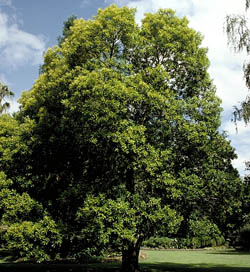Tristaniopsis laurina
 |
 |
Kanooka, or Water Gum
Tristaniopsis laurina (Sm.) Peter G.Wilson & J.T.Waterh.
The forest tree Tristaniopsis laurina, commonly known as the Kanooka or Water Gum, belongs to the Myrtaceae family, and is related to the eucalypts.
It occurs naturally on moist, well-drained sites along the east coast of Australia, from the Brisbane River in Queensland, through coastal New South Wales to the Gippsland region of Victoria. It is commonly found growing along creek banks and in rainforest openings in light shade to full sunlight.
 The
species grows from 5 m to 15 m in height, is ideally suited to a large garden,
and has also been planted as a street tree in Sydney. It grows slowly and rarely
attains a large size in southern Australia.
The
species grows from 5 m to 15 m in height, is ideally suited to a large garden,
and has also been planted as a street tree in Sydney. It grows slowly and rarely
attains a large size in southern Australia.
An attractive and compact shade tree in cultivation, T. laurina has a smooth bark when young, becoming scaly as the tree matures. The leaves are 5-12 cm long, 1-2 cm wide, glossy dark green above with a paler under-side, and are alternately placed along the stems. The flowers are cream to orange-yellow in colour, being produced in short clusters in January and early February. The individual flowers are about 10 mm in diameter with five small, rounded petals and stamens united in five groups. The seed capsules are woody, globular in shape and 6-8 mm in diameter.
Tristaniopsis laurina is grown from seed which normally germinates after three or four weeks. No special pre-sowing treatment is needed. The seed should be sown in a loose, well-drained propagation mix at a depth equal to the diameter of the seed. When the seedlings reach a height of 1-2 cm they should be pricked out into a large container until they have grown to a size suitable for planting out.
The frost tolerance of this species varies and gardeners in southern parts of Australia should endeavour to obtain seed from their local region in preference to that collected in northern NSW or Queensland. If you wish to collect your own seed, capsules may be picked in autumn while still green and left in the sun to dry and open. A permit may be required in some States if wild seed is to be collected.
This tree grows well in cultivation and tolerates a variety of soil types from well-drained rocky soils to heavy clay loams, provided ample water is available. Being a small rainforest tree, it will tolerate light shade, though growth is more rapid in full sun.
Scale insects commonly attack this species and leaf-hoppers and leaf-eating beetles occasionally attack the leaves but damage is rarely severe enough to warrant spraying. Chemical control, if used, should focus on lower toxicity products that cause less environmental damage. Contact local experts for advice.
The timber of T. laurina is close grained, tough, strong and fairly light in weight - it is ideal for the commercial production of tool handles, mallets, golf club heads and wooden screws.
Note: in 1982 the genus Tristania was reviewed by taxonomists and the Australian members of the genus were divided into 5 genera including Tristania, Lophostemon and Tristaniopsis.
Text by Stephen Hughes, ANBG (1980)
Name meaning: Tristaniopsis laurinaTristaniopsis - combining Tristan, in honour of Jules M.C.Tristan (1776 - 1861), a French botanist, and iopsis from a Greek word meaning appearance, thus suggesting 'similar to Tristania'; laurina -a Latin adjective derived from laurus, a laurel or bay tree, and the suffix, inus, indicating resemblance. |
![An Australian Government Initiative [logo]](/images/austgovt_brown_90px.gif)

